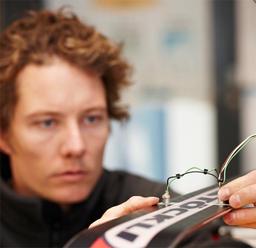Friction of engineering polymers on snow: snow wetness, surface roughness and wettability
Fabian Wolfsperger, Denes Szabo, Hansueli Rhyner, Schweizer Lawinenforschungsinstitut, Davos

For decades, considerable effort has been made to find surfaces which decrease snow friction to a minimum. In contrast to minimizing friction, the goal of this study was to find a material with acceptable gliding performance while providing high structural strength. For the sports equipment industry both, manufacturing cost and product performance of a wide range of snow sport equipment (e.g. skis for children, sledges, snow skateboards) are promised to be optimized by that. Static and kinetic friction coefficients (COF) on snow of twelve gliders made of six different polymers (PE; PA; POM; PA/Glass fibre (GF); PA/GF/Additive; PA/PP/GF) were measured on a linear friction tester (v = 0.1 m/s) placed in a cold chamber. Of each polymer two gliders were built and tested: one with a smooth surface, another one with a stone grinded surface. Roughness parameters (average roughness Ra) and dynamic contact angles were measured to characterize the surfaces. Dry and wet snow samples were prepared by grinding ice into powder followed by sieving, compressing and snow sintering. The snow surface temperature was measured before each experiment with a pyrometer. Liquid water content of approximately 10% to 15% was generated directly before each experiment by applying infrared light for 60 s. Every sample was measured three to five times. Friction coefficients on wet and dry snow were correlated with mean Ra-values and mean contact angles. Mean static COF were found from 0.05 to 0.375 on dry, and from 0.133 to 0.674 on wet snow. On dry snow, only a moderate negative relationship between static COF and contact angle was found (rpearson =-0.6), whereas on wet snow a strong negative relationship was found (rpearson = -0.92). Static COF and Ra showed a moderate relationship only on dry snow (rpearson = 0.62). Excluding PE and ABS, smooth samples showed distinctly lower static friction than structured samples. No adequate polymer - surface structure configuration with acceptable snow gliding performance and engineering properties was found. The typical texture for PE ski bases did not sufficiently decrease snow friction of the tested alternative polymers. On wet snow hydrophobicity is the most important factor for good gliding at the tested velocities. On dry snow surface roughness has a stronger influence than hydrophobicity.